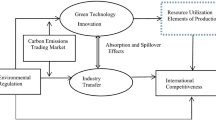Abstract
Corporate social responsibility is imperative for manufacturing companies to achieve sustainable development. Under a strong environmental information disclosure system, polluting companies are disadvantaged in terms of market competitiveness, because they lack an environmentally friendly image. The objective of this study is to analyze productive inefficiency change in relation to toxic chemical substance emissions for the United States and Japan and their corresponding policies. We apply the weighted Russell directional distance model to measure companies’ productive inefficiency, which represents their production technology. The data encompass 330 US manufacturing firms observed from 1999 to 2007, and 466 Japanese manufacturing firms observed from 2001 to 2008. The article focuses on nine high-pollution industries (rubber and plastics; chemicals and allied products; paper and pulp; steel and non-ferrous metal; fabricated metal; industrial machinery; electrical products; transportation equipment; precision instruments) categorized into two industry groups: basic materials industries and processing and assembly industries. The results show that productive inefficiency decreased in all industrial sectors in the United States and Japan from 2001 to 2007. In particular, that of the electrical products industry decreased rapidly after 2002 for both countries, possibly because of the enforcement of strict environmental regulations for electrical products exported to European markets.




Similar content being viewed by others
Notes
This is so because the linear expansion of pollution abatement costs and pollution reduction does not necessarily change the pollution reduction per abatement cost (Pethig, 2006).
Reports for the TRI must be filed by the owners and operators of facilities that meet all of the following criteria: (1) TRI reporting requirements are limited to manufacturing facilities with major standard industrial classification (SIC) code groups 20–39. In 1997, the USEPA added another seven industry sectors to the TRI requirements. These sectors started to submit reports from 1998. (2) The number of full-time employees must be 10 (or the equivalent of 20 000 hours of work per year) or more. (3) Any facility that manufactured or processed more than 25 000 pounds or otherwise used more than 10 000 pounds of a listed toxic chemical during the course of the calendar year is required to submit a report.
The RoHS, REACH and ELV were promulgated in 2003, 2006 and 2000 and came into force in 2006, 2007 and 2003, respectively.
The JCIA has nearly 180 member companies, with 80 organizations engaged in the manufacturing and handling of chemical products and related services. The JCIA has actively undertaken activities to fulfill its mission of promoting the balance between economic development and environmental protection.
References
Akao, K. and Managi, S. (2007) The feasibility and optimality of sustainable growth under materials balance. Journal of Economic Dynamics and Control 31 (11): 3778–3790.
Barros, C.P., Managi, S. and Matousek, R. (2012) The technical efficiency of the Japanese banks: Non-radial directional performance measurement with undesirable output. Omega 40 (1): 1–8.
Bunge, J., Cohen-Rosenthal, E. and Ruiz-Quintanilla, A. (1996) Employee participation in pollution reduction: Preliminary analysis of the Toxics Release Inventory. Journal of Cleaner Production 4 (1): 9–16.
Chen, P.C., Yu, M., Managi, S. and Chang, C. (2011) Non-radial Directional Performance Measurement With Undesirable Outputs. Sendai: Tohoku University. Working paper.
Claver, E., López, M.D., Molina, J.F. and Tarí, J.J. (2007) Environmental management and firm performance: A case study. Journal of Environmental Management 84 (4): 606–619.
Färe, R., Grosskopf, S. and Pasurka Jr, C.A. (2001) Accounting for air pollution emission in measures of state manufacturing productivity growth. Journal of Regional Science 41 (3): 381–409.
Fujii, H., Kaneko, S. and Managi, S. (2010) Changes in environmentally sensitive productivity and technological modernization in China's iron and steel industry in the 1990s. Environment and Development Economics 15 (4): 485–504.
Fujii, H., Managi, S. and Kawahara, H. (2011) The pollution release and transfer register system in the US and Japan: An analysis of productivity. Journal of Cleaner Production 19 (12): 1330–1338.
Jaffe, A.B., Newell, R.G. and Stavins, R.N. (2005) A tale of two market failures: Technology and environmental policy. Ecological Economics 54 (2–3): 164–174.
Kammerer, D. (2009) The effects of customer benefit and regulation on environmental product innovation: Empirical evidence from appliance manufacturers in Germany. Ecological Economics 68 (8–9): 2285–2295.
Khanna, M., Quimio, W.R.H. and Bojilova, D. (1998) Toxics release information: A policy tool for environmental protection. Journal of Environmental Economics and Management 36 (3): 243–266.
Koehler, D.A. and Spengler, J.D. (2007) The toxic release inventory: Fact or fiction? A case study of the primary aluminum industry. Journal of Environmental Management 85 (2): 296–307.
Kolominskas, C. and Sullivan, R. (2004) Improving cleaner production through pollutant release and transfer register reporting processes. Journal of Cleaner Production 12 (7): 713–724.
Kwon, H.M. (2006) The effectiveness of process safety management (PSM) regulation for chemical industry in Korea. Journal of Loss Prevention in the Process Industries 19 (1): 13–16.
Lanjouw, J.O. and Mody, A. (1996) Innovation and the international diffusion of environmentally responsive technology. Research Policy 25 (4): 549–571.
Managi, S., Opaluch, J.J., Jin, D. and Grigalunas, T.A. (2005) Environmental regulations and technological change in the offshore oil and gas industry. Land Economics 81 (2): 303–319.
Oltra, V. and Saint-Jean, M. (2009) Sectoral systems of environmental innovation: An application to the French automotive industry. Technological Forecasting and Social Change 76 (4): 567–583.
Pethig, R. (2006) Non-linear production, abatement, pollution and materials balance reconsidered. Journal of Environmental Economics and Management 51 (2): 185–204.
World Commission on Environment and Development (WCED). (1987) Our Common Future: The Brundland Report on Environmental and Development. Oxford: Oxford University Press.
Zatz, M. and Harbour, S. (1999) The United States Environmental Protection Agency's 33/50 Program: The anatomy of a successful voluntary pollution reduction program. Journal of Cleaner Production 7 (1): 17–26.
Author information
Authors and Affiliations
Corresponding author
Rights and permissions
About this article
Cite this article
Fujii, H., Managi, S. Productive inefficiency analysis and toxic chemical substances in US and Japanese manufacturing sectors. Asian Bus Manage 11, 291–310 (2012). https://doi.org/10.1057/abm.2012.8
Received:
Revised:
Accepted:
Published:
Issue Date:
DOI: https://doi.org/10.1057/abm.2012.8




